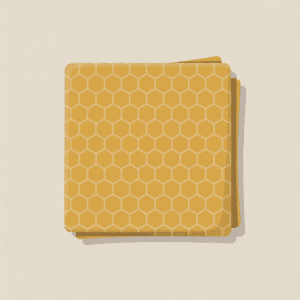Let’s be honest, fighting with a roll of plastic wrap is one of the small, infuriating battles of modern kitchen life. It either refuses to unroll or clings to itself with the force of a thousand magnets. You’re trying to save half a bowl of leftover salad, not audition for a wrestling match.
Thankfully, we have options. Two of the biggest contenders in the reusable food cover game are beeswax wraps and silicone stretch lids.
Both promise to help us ditch the disposables, but they are fundamentally different tools for different jobs. I’ve used both extensively, and I definitely have opinions. So, let’s put them in the ring and see who comes out on top.
The Contenders
In one corner, we have Beeswax Wraps: The all-natural, eco-friendly challenger. These are typically pieces of cotton fabric infused with beeswax, jojoba oil, and tree resin. You use the warmth of your hands to soften the wrap and create a seal over a container or directly around food.
In the other corner, Silicone Lids: The durable, pragmatic workhorse. These are stretchy, food-grade silicone discs that you pull over the top of bowls, cans, and jars to create a super-tight seal.
The Showdown: A Round-by-Round Analysis
Round 1: The Seal (Airtightness)
This isn’t even a fair fight. Silicone lids create a genuinely airtight, often leak-proof seal. You can stretch one over a bowl of soup, turn it sideways (carefully!), and nothing will spill. This is a game-changer for keeping leftovers fresh and preventing fridge smells from mingling.
Beeswax wraps, on the other hand, just cover things. They create a decent barrier, but it’s not airtight. Air can and will get in. For short-term storage or keeping dust off, they’re fine. For locking in freshness, they can’t compete.
Winner: Silicone Lids, by a knockout.
Round 2: Versatility
This is where things get interesting. Silicone lids are fantastic for what they do, but they are limited to round (and sometimes square) containers. They excel at covering bowls, mugs, cans, and jars.
Beeswax wraps can cover almost anything. Half an onion? A block of cheese? A sandwich? A loaf of artisan bread? The wrap conforms to any weird shape you throw at it. You can’t exactly stretch a silicone lid over a baguette.
Winner: Beeswax Wraps. They’re the jack-of-all-trades for odd shapes.
Round 3: Ease of Use & The Clean-Up
Let’s talk about the daily grind. Silicone lids are simple: pick one that fits, stretch it over, and you’re done. When it’s dirty? Toss it in the dishwasher. This is a massive, gigantic, colossal win for anyone who is already washing enough dishes.
Beeswax wraps require a bit more finesse. You have to hold it in place for a few seconds for the wax to mold. And cleaning is a chore. You must wash them by hand with cool water and mild soap (hot water will melt the wax) and then let them air dry. It’s not hard, but it’s another manual task on your to-do list.
Winner: Silicone Lids. The dishwasher-safe factor alone makes them the clear winner for convenience.
Round 4: Durability & Lifespan
A good set of silicone lids can last for years, maybe even a decade. As long as you don’t tear them or slice them with a knife, they are incredibly durable.
Beeswax wraps have a finite lifespan. With regular use and proper care, they’ll last about a year before the wax cracks and they lose their stickiness. You can “revive” them by re-melting the wax in the oven, but they are fundamentally a semi-perishable item.
Winner: Silicone Lids. It’s an investment that lasts.
Round 5: The Eco-Footprint (Full Lifecycle)
This is the beeswax wrap’s comeback round. They are made from natural, renewable materials. At the end of their life, you can cut them into strips and toss them in your compost bin, where they will fully biodegrade. It’s a beautiful, zero-waste lifecycle.
Silicone is a bit more complicated. While it’s a durable alternative to single-use plastic and is made from sand (silica), it’s not biodegradable. It won’t break down in a landfill for hundreds of years, and it’s not easily recyclable in most municipal programs. Its eco-friendliness comes from its longevity, not its disposal.
Winner: Beeswax Wraps, for their perfect, earth-friendly exit strategy.
The Final Verdict: Do You Need Both?
After all the rounds, there’s no single champion. Declaring one better than the other is like saying a hammer is better than a screwdriver. They’re different tools for different tasks.
Here’s my final, opinionated take:
You should buy Silicone Lids if: Your main goal is to replace plastic wrap for covering bowls of leftovers. They are more practical, create a better seal, and are infinitely easier to clean. For 90% of people starting out, a set of silicone lids is the most useful first purchase.
You should buy Beeswax Wraps if: You frequently store things like blocks of cheese, half-used vegetables (like onions or avocados), or loaves of bread. They are the perfect tool for those specific, oddly-shaped jobs, and their compostability is a huge plus for the eco-conscious.
So, what’s the real answer? You probably need both.
Start with a versatile set of silicone stretch lids. They will become the workhorses of your kitchen. Then, add a small pack of beeswax wraps to your collection to handle all the jobs the lids can’t. Together, they form a nearly perfect system that will finally let you win the war against plastic wrap for good.
This page contains affiliate links. As an Amazon Associate, we earn from qualifying purchases
We may also earn a commission from purchases made through other affiliate links at no extra cost to you.
